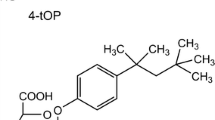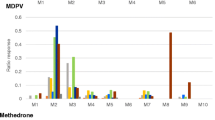Abstract
THE molecules of several cyclodiene insecticides such as heptachlor, heptachlor epoxide, α-dihydroheptachlor1, α-chlordane and β-chlordane are asymmetrical and so exist as racemic modifications capable, in principle, of being separated into enantiomeric forms. Such compounds contain no functional groups amenable to the usual methods for resolution of racemic modifications, and their separation into enantiomeric forms has not been effected, although these forms might conceivably exhibit interesting differences in their interaction with biological systems.
Similar content being viewed by others
References
Büchel, K. H., Ginsberg, A. E., and Fischer, R., Chem. Ber., 99, 405 (1966).
Brooks, G. T., World Rev. Pest Control, 5, 62 (1966).
Brooks, G. T., and Harrison, A., Biochem. Pharmacol., 13, 827 (1964).
Korte, F., Botyu-Kagaku, 32, 46 (1967).
Brooks, G. T., and Harrison, A., J. Insect Physiol., 10, 633 (1964).
Brooks, G. T., and Harrison, A., Nature, 205, 1031 (1965).
Author information
Authors and Affiliations
Rights and permissions
About this article
Cite this article
BROOKS, G., LEWIS, S. & HARRISON, A. Selective Metabolism of Cyclodiene Insecticide Enantiomers by Pig Liver Microsomal Enzymes. Nature 220, 1034–1035 (1968). https://doi.org/10.1038/2201034a0
Received:
Revised:
Issue Date:
DOI: https://doi.org/10.1038/2201034a0
- Springer Nature Limited
This article is cited by
-
Metabolische Studie bei kombinierter Anwendung von Pesticiden
Internationales Archiv für Arbeitsmedizin (1971)
-
Characterization of oxychlordane, animal metabolite of chlordane
Bulletin of Environmental Contamination and Toxicology (1970)
-
Hydration of HEOD (Dieldrin) and the heptachlor epoxides by microsomes from the livers of pigs and rabbits
Bulletin of Environmental Contamination and Toxicology (1969)





